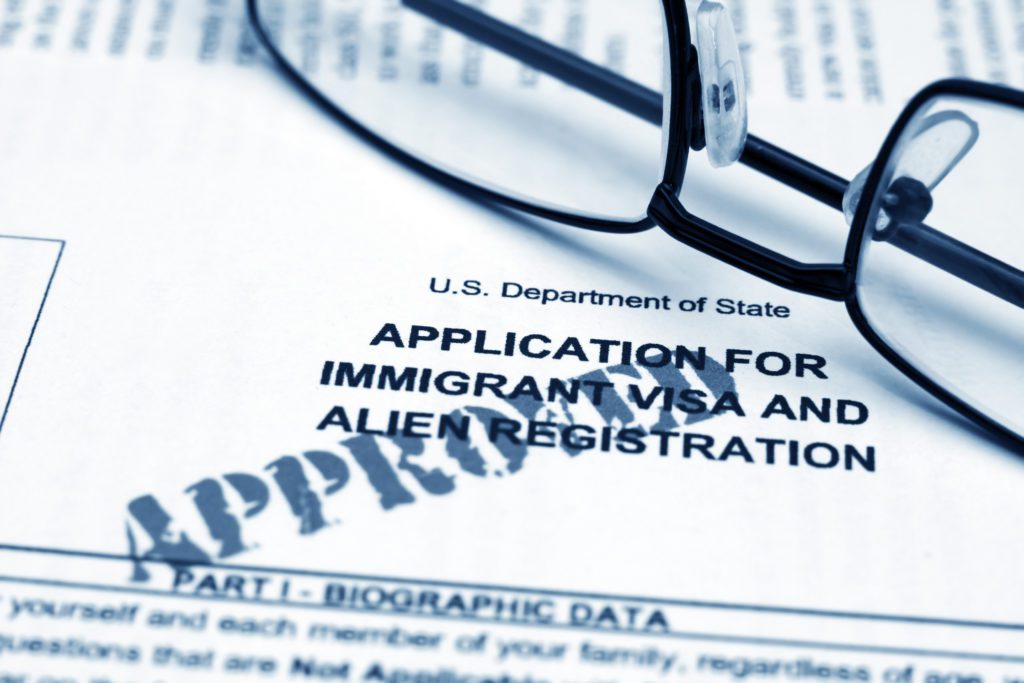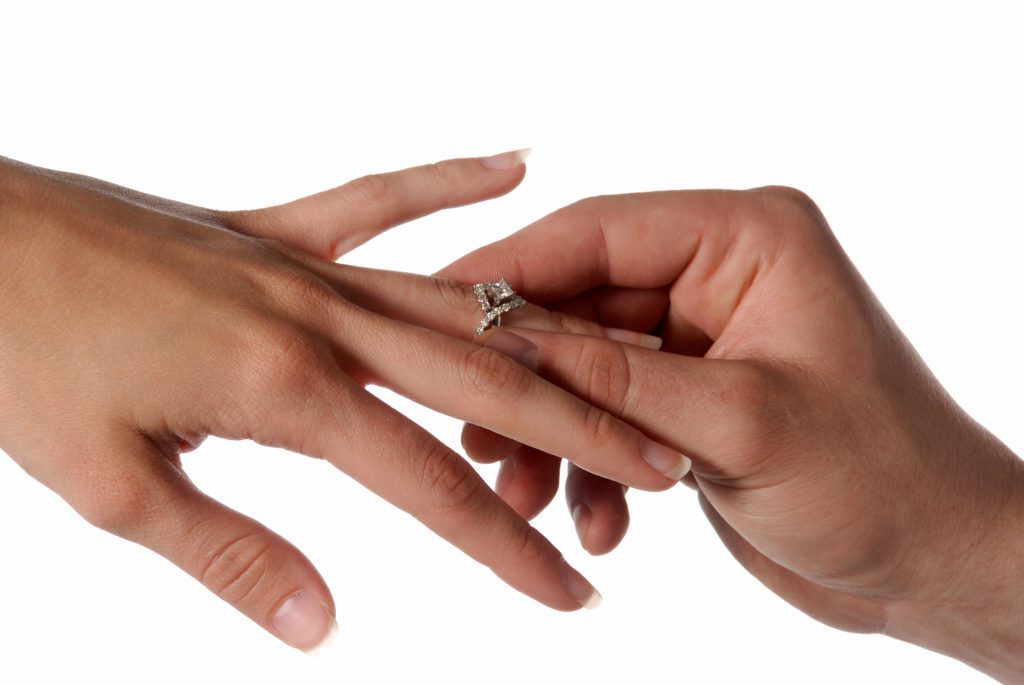The K-1 visa is available to foreign-citizen fiancés of U.S. citizens. It allows a person to travel to the United States to marry his or her sponsor, provided that the marriage takes place within 90 days of the immigrant’s arrival in the country. K-1 visa processing times can vary, but typically, it takes between 7 and 10 months to obtain one. Because there are so many factors involved in getting this type of nonimmigrant visa, you’ll find the answers to some common questions here.

How Much Does a K-1 Visa Cost?
Filing the initial form that starts the application for a K-1 visa costs $535. However, there are other costs associated with bringing a fiancé to the U.S., including:
- Nonimmigrant visa application processing fee ($265)
- Medical examination (costs vary)
- Administrative costs, such as translation and photocopying charges, fees for getting necessary documents and travel expenses (costs vary)
Typically, for just one person without children to immigrate to the U.S. on a K-1 visa, the cost is between $1000 and $1300. Every person coming to the U.S. on this type of visa must pay the nonimmigrant visa application processing fee, which is currently $265, so if your fiancé has two children who will also come to the U.S., he or she will pay an additional $530 for their applications. The fees can vary further based on individual circumstances.
Related: Adjustment of Status Cost 2022
How Long is the Wait for a Fiancé Visa?
Generally, it takes between 7 and 10 months to complete, file and receive a decision on a fiancé visa. The U.S. citizen applying for a fiancé must provide proof of his or her citizenship, as well as evidence of the courtship and meeting within the past 2 years. After U.S. Customs and Immigration Services reviews the petition, it will forward the petition to the National Visa Center, which will complete background checks; at the same time, the Department of State will send the fiancé forms electronically to fill out. Then, the file goes to the U.S. embassy that has jurisdiction over the fiancé’s home – and the embassy will send the fiancé further instructions (such as getting a medical exam and scheduling their interview). Finally, the fiancé will attend an interview at the U.S. consulate.
Article: How Long Does Adjustment of Status Take?
Which is Faster: Fiancé Visa or Spouse Visa?

The processes of obtaining a fiancé visa and obtaining a spouse visa are very similar, but many people wonder whether it’s smarter to bring a fiancé to the U.S. or to get married outside the country and apply for the spouse’s visa after the fact. A fiancé visa is typically faster than a spouse visa is – but there’s a trade-off: a fiancé visa costs more and requires a second process here in the United States to actually get the green card.
Can a Fiancé Visa Be Denied?
The U.S. government can deny fiancé visas. In fact, a little over 35 percent of all K-1 visa applications are rejected. Usually, this happens when the petitioner doesn’t meet the requirements, when the forms are filled out incorrectly or when there’s a lack of evidence that supports a genuine relationship between the fiancé and the U.S. citizen petitioner. If USCIS denies your fiancé visa, you may have the right to appeal – and many people turn to a Norfolk immigration attorney when circumstances like these arise. It may be helpful to know that most denials are eventually reversed after appeals; only about 40 percent of appeals are ultimately unsuccessful.
Article: What Happens if Adjustment of Status is Denied

Why Would a Fiancé Visa Be Denied?
There are several reasons that the U.S. government might deny a fiancé visa. One of the biggest reasons, however, is the lack of a relationship that warrants this type of visa. When you apply for fiancé immigration, you must show USCIS that you have a legitimate relationship and that you’ve met your fiancé at least once, in person, in the past two years – and your fiancé must also convince a consular officer that you are in a legitimate relationship. Other reasons a K-1 visa might be rejected or denied include:
- Administrative errors, such as mistakes on the paperwork
- Missed deadlines for filing or providing documentation
- Failure to meet basic requirements (like proving that you met your fiancé at least once in the past)
- Failure to provide proof of meetings with your fiancé (the proof must meet specific requirements, as well)
- Failure to prove intent to marry
- A fiancé’s criminal record or certain medical conditions
- Misrepresentation of facts or other application-related data
If your petition is denied or rejected, you may want to talk to an attorney about an appeal.
What Percentage of Fiancé Visas Are Approved?
The government approves around 65 percent of fiancé visas on the first try. If your application is rejected, you can correct the errors and re-file it. If your application is denied, you may be able to appeal USCIS’s decision. About 60 percent of appeals are successful.
What is the Minimum Income Requirement for a K-1 Visa?
The U.S. citizen petitioner must make a certain amount of money to apply for a K-1 visa on behalf of a fiancé. The income requirement varies based on how many dependents the petitioner and the fiancé have. For example, a U.S. citizen and his or her fiancé who do not have children or other dependents need to make less money than a couple who has one or more children or other dependents. The citizen must make at least 125 percent of the national poverty guidelines, which are subject to change at any time. The most current poverty guidelines are listed on Form I-864P. Currently, a person must make at least $21,550 per year when he or she has no dependents (other than the fiancé) to be eligible for a K-1 visa.
What Do I Need to Bring to My K-1 Visa Interview?
After a U.S. citizen petitions for a fiancé visa, the fiancé must attend an interview. If the fiancé has any children, they are also supposed to attend the interview. This checklist outlines what you should bring to the K-1 visa interview:
- DS-160 confirmation. You must print the confirmation page that shows you completed Form DS-160 and bring it with you.
- Form I-129F, Petition for Alien Fiancé. You should bring original copies of all the supporting documents your soon-to-be spouse filed with the form, as well.
- Form I-797, Notice of Action. Bring a photocopy of the USCIS letter that shows your I-129F was approved.
- A passport. You must bring your valid passport to the interview, and it should be valid for at least 6 months past the date you intend to stay in the U.S.
- Medical exam results. You must bring your medical exam reports, including your vaccination record, and they must be in an envelope that was sealed by the physician who conducted your exam. The only exception to this is when the results have already been sent directly to the consulate.
- Form I-134, Affidavit of Support. Bring your original Affidavit of Support – the one signed by the U.S. petitioner in black ink – as well as all the supporting financial documents.
- Passport-style photos. You must bring current (within 30 days) passport-style color photos of yourself.
- Birth certificate. You need an original full-form birth certificate – not a short-form birth certificate.
- Divorce or death certificates of any previous spouses. If you or your fiancé have been divorced or widowed, you must provide divorce or death certificates for any previous spouses you’ve had. That way, you can prove the legal termination of your prior marriages.
- Police certificate. You need a police certificate from your country of residence, as well as all countries where you lived for 6 months or more since the age of 16.
- Evidence of a valid relationship with your petitioner. You must bring an updated statement of your intent to marry the petitioner and provide proof that you have a valid relationship. This proof can include things like photos of the two of you together, emails between you and phone bills that show you’ve called each other and had lengthy discussions.
Can I Bring My Girlfriend to the USA?
You can bring your girlfriend (or boyfriend) to the U.S. on a fiancé visa – but only if you two intend to be married within 90 days of his or her arrival. Alternatively, you can get married outside the country and bring your new spouse to the U.S. on a spouse visa, although that type of visa typically takes longer (but it costs less).
Can I Marry My Girlfriend on a Tourist Visa?
You can marry your girlfriend or boyfriend when he or she is in the U.S. on a tourist visa, but there’s a caveat. A person can’t come to the U.S. on a tourist visa with the sole intention of getting married and then applying for permanent residency through an adjustment of status. Doing so can be considered visa fraud.
Do You Need to Talk to a Lawyer About K-1 Visa Processing Times or Other Fiancé Immigration Issues?
If you’re interested in bringing your fiancé to the U.S. on a K-1 visa, we may be able to help you. Call us at 757-464-9224 to talk about your options or to get case-specific advice on fiancé immigration.